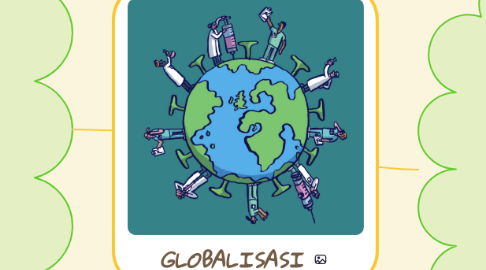
1. Past fifty years have seen many improvements in transport technology
1.1. This has made delivery of goods much faster and at lower costs
2. Foreign Trade, Market Integration
2.1. Foreign trade creates opportunity for producers to reach beyond domestic markets
2.2. Foreign trade is a way for buyers to expand choice of goods beyond what is domestically produced
2.3. Foreign trade results in integration of markets in different countries
3. Apa itu Globalisasi?
3.1. Process of rapid integration and interconnection between countries
3.2. More and more goods, services, technology and investments are moving between countries
3.3. People are also migrating between countries in search of better income, better jobs or better education
4. Multi-National Companies
4.1. - Wide choice of goods and services available today, mainly a result of multi-national corporations
4.2. - Till the middle of twentieth century, production organised within countries
4.3. - This was before MNCs came on the scene
4.4. - Factors controlling location:
4.4.1. Offices and factories where there is availability of cheap labour
4.4.2. Customer services where there is availability of human resource
4.4.3. 50-60% cost savings
4.5. - A company that owns or controls production in more than one nation is called an MNC.
4.6. - Example:
4.6.1. Product design in US and Europe
4.6.2. Components manufactured in China
4.6.3. Assembly in Mexico and Eastern Europe
4.6.4. Customer services from India
4.6.5. Products sold everywhere
4.6.6. Nestle, Microsoft, Adobe, Coca-Cola etc
5. Interlinking Production
5.1. Investment made by MNCs is foreign investment
5.2. Ways of interlinking production
5.2.1. Partnership
5.2.1.1. - At times, MNCs set up joint production with local companies
5.2.1.2. MNCs provide money for additional investments, bring latest technology for production, and local companies provide resources onsite
5.2.2. Outsourcing
5.2.2.1. MNCs place orders for goods with local companies, these goods are marketed and sold by MNCs under their own brand names worldwide
5.2.2.2. Garments, footwear and sports items are examples. MNCs have power to control price, quantity, quality, delivery, labour conditions
5.2.3. Buy companies
5.2.3.1. Most common route for MNCs is to buy up local companies and expand production
5.2.3.2. Example: Cargill Foods (American MNC) bought Parekh Foods, which had large customer base and four oil refineries in India. Cargill is now the largest edible oil producer in India with a capacity of 5 million pouches per day
6. Factors Enabling Globalisation
6.1. Rapid improvement in technology has been one of the main factors driving globalisation
6.2. Many developments in information and communication technology have taken place in recent times
6.2.1. Telecommunication (telephone, fax), computers, internet, satcoms (satellite communication)
7. LPG Policy in India: Liberalisation, Privatisation, Globalisation
7.1. Trade Barriers: restrictions imposed by the government on foreign trade
7.1.1. Import tax, quotas
7.1.2. Imposed by Indian government after independence, in the 1950s and 1960s
7.1.3. Eventually led to severe decrease in GDP and near-collapse of economy
7.2. Liberalisation: PV Narasimha Rao and Manmohan Singh
7.2.1. To avert economic collapse, Narasimha Rao and Manmohan Singh planned a new budget starting around 1991
7.2.2. Barriers on foreign trade and investment were removed to a large extent - goods and services could be imported or exported easily
7.2.3. Removing trade barriers is known as liberalisation - businesses are allowed to decide freely what to import and export
8. WTO (World Trade Organization)
8.1. Free Trade: belief that all barriers to foreign trade and investment are harmful
8.2. WTO was started at the initiative of the developed countries
8.3. Establishes rules regarding international trade and sees that the rules are obeyed
8.4. 164 member countries
8.5. In theory, free trade for all; in practice, often WTO enables developed countries to retain trade barriers and forces developing countries to remove them
8.5.1. Example: agricultural products debate
9. Impact of Globalisation on India
9.1. Advantageous to consumers especially well-off ones in urban areas, who have greater choice and can enjoy improved quality
9.2. Effect has not been uniform among producers and workers
9.2.1. MNCs - benefited; wider market, large number of well-off buyers
9.2.2. Local companies that have MNC tie-up - benefited; see above
9.2.3. Large Indian companies - benefited; increased competition driving quality control, investment in new technology, production methods, some have themselves emerged as MNCs
9.2.4. IT Companies - benefited; example call centres, data entry, etc
9.2.5. Small producers - loss; hit hard due to competition, several units shut down due to losses
9.2.6. Workers - loss; no job security, employment on temporary instead of permanent basis, conditions of work in organised sector now resemble that of unorganised sector
